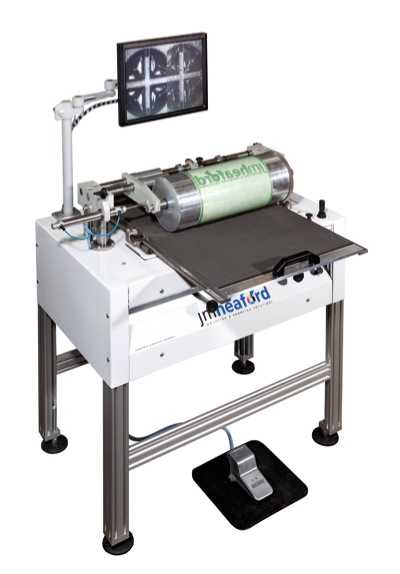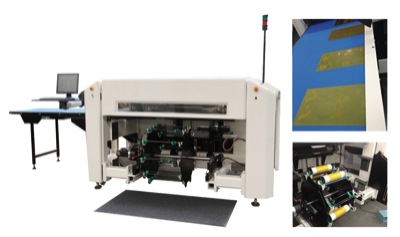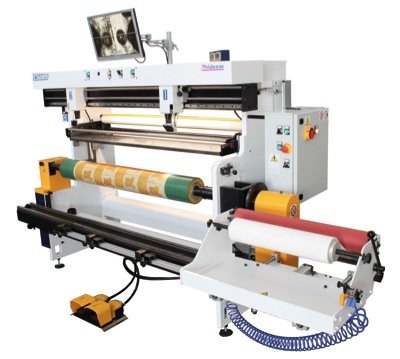Camis Irisleeve mounter
Using plate mounting and proofing machines avoids wasted press time printing out of register jobs and reduces downtime. Add in other cost savings, such as on labour, inks and substrate, and the return on investment is not far off. By Neel Madsen.
The majority of plate mounters used in the label industry today use video cameras for register and there are numerous options available to assist in applying the plate to the adhesive layer. The level of automation mounters and proofers introduce into the process varies, with machines available for any type of application and size of company.
Reversing the position
JM Heaford has introduced the narrow web FTS mounter, which reverses the usual position of the cameras and mounts the plate on a cushioned table with the print surface facing downwards and the cameras pointing up with the cylinder or sleeve held above the table. This new approach of using an inverted cushioned table is patent pending.
Once the plate is positioned, the cylinder or sleeve is driven down into contact with the plate, and the action of then sliding the cushioned table back and forth applies the plate around the cylinder or sleeve under even pressure.
This provides perfect uniform adhesion and eliminates the possibility of trapped air pockets that can occur with the traditional time consuming practice of applying hand pressure. The tape can be applied to the plate roller in exactly the same manner as the plate.
Sally-Anne Heaford explained that training takes only matter of minutes, and that no specific skills are needed as the plate is simply laid on the flat cushioned table and is not in contact with the sticky mounting tape while it is being positioned. This method of mounting discourages the common last minute corrections that operators make to try to line up the bearer bars more accurately which does nothing to improve overall plate register and simply increase the risk of plate lift during the run.
The advantage often put forward to support automated mounting machines is that automation takes the individual out of the equation and plate mounting therefore becomes more consistent (but not necessarily more accurate).
The FTS unit requires only that the operator positions the plate centrally and lines up two horizontal bars on the video screen at an optical magnification of 56x. Compared to an automated mounting machine, the plates are mounted at least as accurately and significantly faster at a capital cost which is substantially less.
While it is difficult to exactly quantify the cost savings arising from quicker and more accurate mounting, it is a given that any remount costs downtime and wasted substrate. Re-mounted plates are more susceptible to plate lift which in turn leads to further downtime and more wasted substrate. It is also a given that with run times getting shorter, the speed of plate mounting becomes a critical factor and idle presses waiting for mounted plates cost money.
 JM Heaford’s FTS mounter
JM Heaford’s FTS mounter
One of Heaford’s customers calculated that the time saved through reduction in waiting time paid for the investment in the FTS mounter in a few weeks. ‘Consistently accurate fast plate mounting should be a key objective of any production plan and the FTS mounter meets this objective completely,’ concluded Sally-Anne Heaford.
Improved standardisation
Eurograv Limited is the global distributors for the Camis Total Work Flow range of flexographic plate mounting and proofing machinery. The company said that there is still a steady demand for proofing amongst its clients.
Export sales director, Mike Attard, explained, ‘Clients, particularly those master flexographers with a multitude of flexo presses, do not want to take any chances when mounting new plates. Proofing the plates allows print managers to get the sleeve ready for printability. They can check the accuracy and registration of plates and the actual printed image itself as well as any TIR (total indicated runout) issues with the sleeve, tape or plate.
This allows print managers to assess the impact of any particular job before it goes to print, identify problem areas and make intelligent considerations before wasting ink, film, solvent and press time.’
Even though the Camis systems remove the manual application of the plate and the tape, thus raising the standardisation of the whole plate mounting process and print quality as well, Mr Attard said that clients still see lot of issues with TIR of older sleeves and issues from time to time not only with older plates, but also freshly produced plates.
He said, ‘We had a particular instance at a North American client which during the commissioning of a 60 inch wide Camis Iriflex proofing system saw that after proofing five colours the subsequent colours where all a few microns undersized. The sixth, seventh and eighth sleeves would not proof without increasing the impression. We then saw a very slight reduction in the print length of those last plates when the plates were proofed. This verified that the plates were ever so slightly smaller and the issue was traced back to a new set of UV bulbs being fitted to one of their older plate processors mid run!’
Last year Eurograv installed several Iriflex proofing systems worldwide, from a 700 mm unit for a high quality tissue printer in Eastern Europe to the widest being an 80 inch system going to a prominent independent printer in Pennsylvania, in the US.
Return of investment is estimated to be around 6 to 12 months, depending on the amount of presses the mounter proofer is actually serving and the amount of jobs processed each day.
Mr Attard said, ‘We have a leading printer in North Carolina that had five other mounters installed, but on a daily basis they were still stopping one of their three F&K presses to reset the plate, tape or swap the sleeves due to TIR issues.’ He continued, ‘After installing a Camis 1514, the client calculated the payback was within six months!’ Mr Attard explained that the quick payback has a lot to do with the combination of the standardised and repeatable tape and plate applications that the Camis Total Work Flow Systems afford the client, plus the abilityto see the job before printing.
This American client retained the proofing route and subsequently ordered a 1700 wide Iriflex 1714 complete with chrome proofing drum, motorised cameras, plate mounting table, plate pressure roller and Taper Slide tape applicator.
In the UK, Eurograv has just secured an order for a third machine from an existing client who bought the first Camis in the early 2002. Mr Attard said, ‘We developed a four-camera machine for this client five years ago and now they have ordered a 1650 wide Irisleeve six-camera Total Work Flow system. We have several multinational groups with three, four or five machines, and some smaller independents with two or three machines.’
In the past few weeks, the company has seen repeat business from clients in Spain, Russia, the UK and the US. These printers list the advantages of the Camis mounting systems as ease of use, the speed of the whole process (one full width wrap of tape and one wide plate, sleeve on sleeve off in less than three minutes), the repeatability and minimal press downtime due to the total workflow approach.
 The FAMM HS from AV Flexologic
The FAMM HS from AV Flexologic
Full automation
AV Flexologic’s portfolio of Fully Automated Mounting Machines, or FAMM, includes the FAMM HS (high speed) for narrow web, the Flat- FAMM for post-print corrugated and the FAMM for pre-print liner.
The latest addition is the FAMM HS, a robotic plate mounter for the narrow web industry, which can mount a full set of flexo plates for an eight colour job on cylinders, or sleeves, in one sequence lasting less than eight minutes.
Aimed at customers with a standardised narrow web workflow and demands for short runs, quick changeovers and high quality, the mounter demands only minimal operator intervention and is capable of handling 750 cylinders per day if working round the clock. This fully automated process starts with cylinders being positioned on a carousel while the plates are laid on a conveyor belt, which transport them into the machine until detected at the pickup position. A mounting mark on the plate is recognised automatically and a plate manipulator lifts the plate to the correct mounting position.
Cameras then check the X and Y position of the mounting marks, and the position of the plate is adjusted until it is within the preset tolerances. The carousel then places the cylinder in front of the lift and the plates are mounted. Once this process is complete,a digital proof is made along with a quality report, which is stored with the job file in the computer. Earlier this year, AV Flexologic established a US division in Ohio and also celebrated the 30th FAMM installation worldwide at Amcor Flexibles in Moorabbin, Australia.
Finest adjustment
Tectonic International’s Flexico V5 plate mounting machine provides lateral movement as well as forward/back/swivel movement of the plate so that the first plate can be quickly mounted on the cylinder or sleeve with perfect accuracy and the position of the first plate set using the adjustment facility. The finest possible adjustment of the position of the plate is immediately achieved which ensures perfect registration at a fast pace.
The patented Flexico V5 provides hands-free mounting of plates using a rotating rise and fall plate table and a holding clamp. The operator drops the plate onto the plate bed and pulls it forward until the registration marks are under the cameras. When in register, he presses a foot switch and a holding bar falls gently onto the plate holding in perfect position. To be absolutely sure of perfect registration, the operator can then finely ‘swivel’ the plate bed using the two adjusting wheels for perfect registration.
A strip of backing tape is then removed and the plate stuck to the cylinder before the holding bar is released. This prevents any plate movement and maintains perfect registration. With the plate partially adhered to the cylinder, the operator can then release the holding bar, release the cylinder brake and turn the cylinder thus adhering the plate fully.
A pressure roller is available as an optional extra, which irons out the plate gently removing any air bubbles. LED lighting is included along with colour cameras, brilliant targets and TFT monitors, which provide the excellent picture quality necessary for perfect registration.
A tape dispenser adhesive roll holder is included, along with an integral aluminum machine base, as standard. The adhesive application roller, whereby the pressure from the weighted roller minimises the risk of creating bubbles/creases underneath the adhesive tape, is available as an optional extra.






